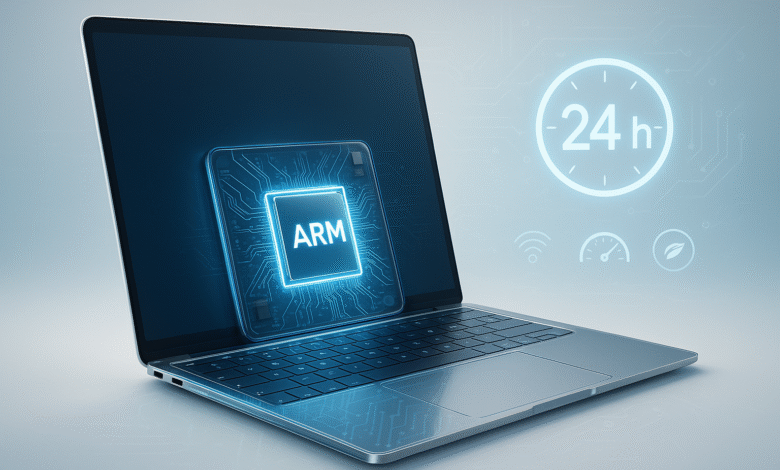
The laptop industry is experiencing a fundamental shift that rivals the transition from desktop to mobile computing. ARM chips are no longer confined to smartphones and tablets – they’re reshaping the laptop landscape with unprecedented battery efficiency, silent operation, and competitive performance. This transformation challenges decades of x86 dominance and promises to redefine what consumers expect from portable computing.
For years, laptop users accepted the trade-off between performance and battery life, often carrying chargers as essential accessories. That paradigm is rapidly changing. ARM processors like Qualcomm’s Snapdragon X Elite and Apple’s M-series chips now deliver full-day computing experiences without compromising on processing power. Major manufacturers including Microsoft, Dell, HP, and Lenovo have embraced this architectural shift, signaling a new era where efficiency meets performance.
The implications extend beyond individual devices. Industry analysts predict ARM processors will capture 40% of the notebook market by 2029, representing a seismic shift in consumer preferences and technological capabilities. This change isn’t just about longer battery life – it’s about enabling entirely new use cases for portable computing, from always-on connectivity to fanless designs that operate in complete silence.
The Technical Foundation: Understanding ARM Architecture
What Makes ARM Different
ARM architecture fundamentally differs from traditional x86 processors through its RISC (Reduced Instruction Set Computing) design philosophy. While x86 chips use CISC (Complex Instruction Set Computing) with hundreds of complex instructions, ARM processors focus on a streamlined set of simple instructions that execute more efficiently.
This architectural approach yields several key advantages:
- Power efficiency: ARM chips typically consume 50-70% less power than comparable x86 processors
- Heat generation: Lower power consumption means less heat, enabling fanless designs
- Battery performance: Modern ARM laptops achieve 20-25 hours of real-world usage
- Always-on capabilities: Instant wake functionality similar to smartphones
Performance Parity Achieved
The performance gap between ARM and x86 has virtually disappeared in many use cases. Qualcomm’s Snapdragon X Elite demonstrates multi-threaded performance that rivals Intel Core i7 processors while maintaining superior energy efficiency. Early benchmarks show these chips delivering competitive performance in:
- Web browsing and productivity tasks
- Content creation workflows
- Video streaming and media consumption
- AI-powered applications
Market Leaders Driving the ARM Revolution
Qualcomm’s Snapdragon Dominance
Qualcomm has emerged as the primary catalyst for Windows on ARM adoption. The company’s Snapdragon X Elite and Snapdragon X Plus processors represent the first serious challenge to Intel’s laptop dominance in over a decade.
Key Snapdragon specifications include:
- Up to 12 high-performance cores
- 45 TOPS AI processing capability
- Integrated 5G connectivity options
- Support for LPDDR5 memory
Despite early challenges with software compatibility, Snapdragon laptops have gained significant traction. Microsoft’s exclusive use of Snapdragon processors in their Surface Pro line demonstrates the platform’s maturity.
Apple’s Proven Success Model
Apple’s M-series chips proved ARM viability in laptops, with the MacBook Air and MacBook Pro achieving unprecedented combinations of performance and battery life. Apple’s success provided the roadmap other manufacturers now follow:
- Unified memory architecture for improved efficiency
- Custom silicon optimization for specific use cases
- Native software ecosystem development
- Premium positioning with compelling user experiences
Intel and AMD’s Response
Traditional x86 manufacturers haven’t ignored the ARM challenge. Intel’s Lunar Lake and AMD’s Ryzen AI 300 series represent direct responses to ARM efficiency gains, incorporating:
- Advanced power management technologies
- Integrated AI accelerators
- Improved performance-per-watt ratios
- Enhanced battery optimization
Software Ecosystem: The Critical Success Factor
Windows on ARM Maturation
Microsoft’s Windows on ARM has evolved significantly since its troubled early years. The latest implementations feature:
Prism Emulator: Advanced x86 translation layer delivering near-native performance for legacy applications
Native ARM Applications: Growing ecosystem of applications optimized for ARM architecture, including:
- Microsoft Office Suite
- Adobe Creative applications
- Popular web browsers
- Development tools and IDEs
App Compatibility: Current compatibility rates exceed 90% for commonly used software, with performance improvements continuing through regular updates.
Developer Adoption Trends
Software developers increasingly prioritize ARM compatibility as the architecture gains market share. Key trends include:
- Universal binaries supporting both ARM and x86
- Cloud-first development reducing local processing requirements
- Web-based applications naturally architecture-agnostic
- AI-powered development tools optimized for ARM NPUs
Battery Life Revolution: The ARM Advantage
Unprecedented Endurance
ARM laptops routinely achieve battery life that seemed impossible just years ago:
- 20-25 hours of typical productivity work
- 15-18 hours of video streaming
- All-day usage without charging anxiety
- Always-connected functionality with minimal power drain
Real-World Performance
Testing reveals ARM processors maintain consistent performance regardless of power source, unlike traditional laptops that throttle performance when unplugged. According to detailed battery life testing by RTINGS, ARM-based laptops consistently outperform x86 alternatives in real-world usage scenarios. This consistency enables:
- Reliable mobile productivity
- Predictable battery planning
- Consistent user experiences across power states
Market Impact and Industry Transformation
Changing Consumer Expectations
The success of ARM laptops has fundamentally altered consumer expectations:
- Battery life now ranks as a top purchase consideration
- Silent operation becomes increasingly valued
- Instant-on functionality expected as standard
- Lightweight designs preferred for portability
Competitive Dynamics
The laptop market has shifted from Intel’s near-monopoly to genuine multi-vendor competition:
- Qualcomm targeting Windows ecosystem
- Apple setting premium standards
- MediaTek and NVIDIA entering the market
- Intel/AMD responding with efficiency improvements
Price Positioning Evolution
ARM laptops initially commanded premium pricing but are rapidly democratizing:
- Entry-level ARM devices starting around $600
- Mid-range options competing directly with x86 alternatives
- Premium models challenging MacBook pricing
- Volume production driving costs down
Gaming and Creative Applications
Current Limitations
ARM gaming remains the platform’s primary weakness:
- Limited native game support
- Emulation performance varies significantly
- Discrete GPU integration still developing
- Gaming ecosystem heavily x86-optimized
Future Potential
Industry developments suggest gaming improvements:
- NVIDIA ARM partnerships targeting gaming applications
- Cloud gaming adoption reducing local processing requirements
- Mobile game porting bringing ARM-optimized titles
- Developer incentives encouraging ARM optimization
Creative Workload Adaptation
ARM processors show strong performance in creative applications:
- Video editing with hardware acceleration
- Photo processing leveraging AI capabilities
- 3D modeling through optimized software
- Audio production with low-latency performance
Future Market Projections
Growth Trajectories
Industry analysis reveals accelerating ARM adoption. Research from TechInsights projects significant market growth, with ARM processors expected to power 40% of notebooks by 2029:
- Current market share: Approximately 18% in 2024
- 2025 projections: Expected 20% market penetration
- 2029 forecasts: Potential 40% market share
- Geographic variations: Stronger adoption in mobile-first regions
Technology Roadmap
ARM laptop evolution continues with upcoming developments:
Second-generation Snapdragon X: Enhanced performance and efficiency expected in 2025
Additional vendors: MediaTek and NVIDIA preparing competitive offerings
Desktop expansion: ARM processors targeting traditional desktop replacements
Enterprise adoption: Business-focused ARM solutions gaining traction
Market Challenges
ARM growth faces several obstacles:
- Software compatibility gaps in specialized applications
- Corporate IT resistance to platform changes
- Gaming limitations restricting enthusiast adoption
- Cost competitiveness with improving x86 efficiency
Industry Expert Perspectives
Technology analysts remain cautiously optimistic about ARM’s laptop future. Leonard Lee from Next Curve notes that Snapdragon processors have “improved the performance-per-watt for Windows laptops, regardless of AI workloads,” while Anshel Sag from Moor Insights & Strategy praised the accessibility of budget Snapdragon X options.

However, challenges persist. ABI Research projects ARM market share will reach only 13% in 2025, citing competition from improved x86 processors and ongoing software compatibility concerns. The reality likely falls between aggressive growth projections and conservative estimates, with adoption varying significantly by use case and market segment.
Recommendations for Consumers
When to Choose ARM
ARM laptops excel for users prioritizing:
- Extended battery life for mobile productivity
- Silent operation in quiet environments
- Lightweight portability for frequent travel
- Always-connected workflows with cellular options
- AI-powered applications leveraging dedicated NPUs
When to Stick with x86
Traditional processors remain preferable for:
- Gaming enthusiasts requiring maximum compatibility
- Professional workflows using specialized software
- Legacy application dependencies
- Maximum raw performance requirements
- Virtualization and development needs
Making the Right Choice
Consider these factors when evaluating ARM vs x86:
- Usage patterns: Mobile vs. desktop-centric workflows
- Software requirements: Critical applications and compatibility
- Performance needs: Sustained vs. burst processing requirements
- Budget considerations: Total cost of ownership including accessories
- Future-proofing: Expected technology evolution and support
The ARM revolution in laptops represents more than incremental improvement – it’s a fundamental reimagining of portable computing priorities. While ARM processors may not immediately replace x86 architecture entirely, they’ve established a permanent and growing presence in the laptop market. Consumer choice now extends beyond specifications to architectural philosophies, with efficiency-focused ARM designs offering compelling alternatives to performance-centric x86 solutions. As software compatibility improves and manufacturing scales increase, ARM laptops will likely capture significant market share, forcing the entire industry toward greater efficiency and innovation. The future of laptops isn’t about choosing between ARM and x86 – it’s about having genuine options that match diverse user needs and preferences.











